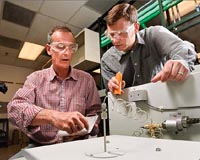 |
Berlin, Germany (SPX) Oct 26, 2010 Whether driving a car, switching on a light, or turning up the heating - we take it for granted that there'll be sufficient energy for us to use at that very moment. But this only works if two basics are in place. Firstly, energy needs to be transported quickly and reliably to the consumer in the required form. Second, energy storage guarantees straightforward access and acts as an 'energy buffer' to fill the gaps in distribution. So, what kinds of storage do we get our everyday energy from? Fossil and renewable fuels - coal, gas, oil, biofuels and hydrogen - contain chemically-stored energy, which they release when burnt. Almost every type of mobility and the vast majority of our electricity and heat depend on these chemical energy stores. Even when we run or cycle, our bodies use biochemical processes to convert the energy-rich molecules they create from food into muscle movements. The advantage of all these substances is that they store energy in a high-density form, are ideal for transport, and quickly and efficiently use an engine or muscle 'machine' to convert the stored energy into movement, power or heat.
The power grid needs more storage With increasing numbers of wind farms and solar energy plants, where the power output fluctuates with the weather, this is becoming increasingly difficult. In addition to implementing a 'smart grid' in the future, this problem can be addressed by the provision of additional energy storage capacity.
The possibilities of potential energy This is done in pumped-storage plants in the Alps, for example. When the water is later allowed to flow back down - when additional power is required - its energy is used to drive turbines. The potential energy of the water in the reservoir situated at a higher location is converted back into electric power as the turbines turn the generators. "These pumped-storage plants offer excellent efficiency, but this technique will be difficult to expand any further," says Stefan Zunft, from the DLR Institute for Technical Thermodynamics in Stuttgart, Germany. This is just one reason why DLR energy research focuses on the development of new storage technologies. In the next blog post, we will tell you more about promising and unusual ideas for energy storage.
The DLR Energy question of the week in 'The future of energy' Year of Science Do you have a question about how our energy supply might look in the future? Or do you want to know, for example, how a wave power plant works and how it can efficiently generate electricity? Then send us your question by email. Science journalist Jan Oliver Lofken will investigate the answers and publish them each week in this blog.
Share This Article With Planet Earth
Related Links Blogs at DLR Powering The World in the 21st Century at Energy-Daily.com
 Building Better Batteries For Cars And Spacecraft
Building Better Batteries For Cars And SpacecraftHouston TX (SPX) Oct 15, 2010 The NASA engineer responsible for the batteries needed for spacewalks now is working at the Department of Energy's National Renewable Energy Laboratory to help design safer lithium-ion battery packs for sky walkers and automobile drivers alike. "We at NASA share the same challenges that DOE and NREL have in developing batteries for cars," said Eric Darcy, the battery group leader at the Na ... read more |
|
| The content herein, unless otherwise known to be public domain, are Copyright 1995-2010 - SpaceDaily. AFP and UPI Wire Stories are copyright Agence France-Presse and United Press International. ESA Portal Reports are copyright European Space Agency. All NASA sourced material is public domain. Additional copyrights may apply in whole or part to other bona fide parties. Advertising does not imply endorsement,agreement or approval of any opinions, statements or information provided by SpaceDaily on any Web page published or hosted by SpaceDaily. Privacy Statement |